
With its colorful and fun graphics, gamified learning environment, intelligent adaptive algorithm and clear and understandable tutorials, Math Whizz can be a highly effective, approachable and efficient way of identifying and remediating skill gaps in K-8 math.
It can ultimately help students become more confident math learners and make math a less stressful subject for all involved.
What We Like
But watch out for…
What Is Math Whizz?
Math Whizz (or Maths Whizz if you’re accessing it from the UK) is a virtual online math tutoring program for elementary and middle school students.
The program provides individualized and targeted self-study math instruction using a combination of direct instruction, adaptive exercises, game-based drill, a gamified learning environment, quizzes and more, all while allowing parents to monitor student progress and development via a digital dashboard.
What Ages Or Grades Is Math Whizz Intended For?
Math Whizz is aimed at students in K-8 math and is common core aligned for these grades.
As it is an individual math tutoring program and not a full curriculum, the program is mostly based on a student’s actual skill, rather than any presumed grade-level math knowledge or particular scope and sequence.
As such, we feel that it can be a good option for homeschooling families, particularly those learning outside of a typical grade progression (such as advanced students and those who are behind), as it allows them to work on skills they need or are capable of developing at their own pace.
Math Whizz Placement Test
To determine which topics a student should be working on (and where to start with them), Math Whizz offers a fairly comprehensive placement test.
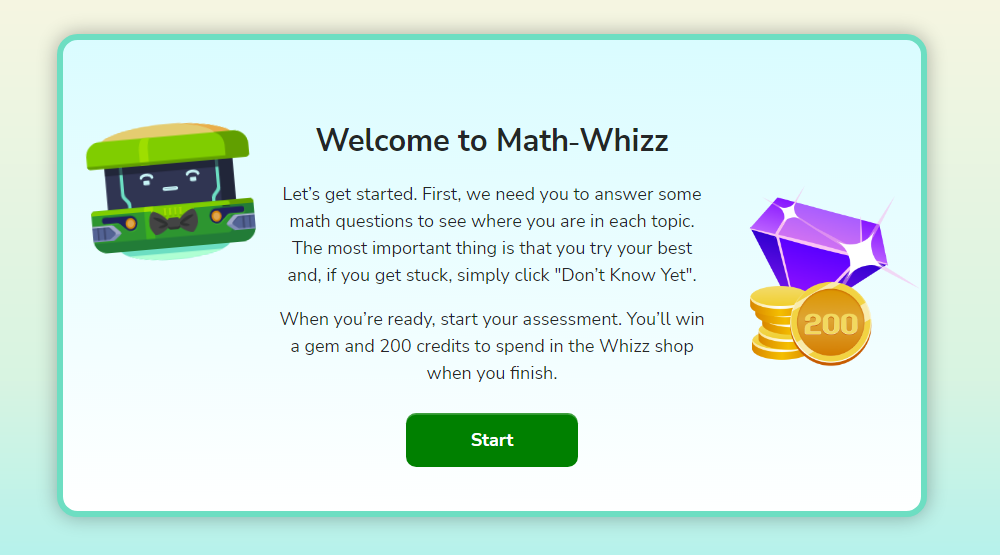
Similar to programs such as ALEKS math, the placement test is done online and is powered by an adaptive question engine, or algorithm.
As they go through different math topics one by one, students are asked to answer a series of problems, which become harder or easier depending on how a student is doing in answering them, stopping when it determines that a student can’t answer any more or that they’re proficient.
The questions are interactive and have students input their questions in very short form or click buttons on the screen and don’t really take a lot of typing or writing skill, which is always good for younger students.

That said, depending on the level and skill of the student, they can get a bit involved for a digital placement test, such as by having students fill out charts or filling in/selecting multiple answers at once.
Once a student has been assessed across several topics, the program builds a unique learning plan based on which skills a student needs to work on.
This division by topic allows the program to really identify and hone in on specific knowledge and skill gaps that a student might have, meaning it yields far more precise and perhaps useful data than a simpler math test might otherwise.
More than that, it actually provides a quantitative assessment of a student’s actual skill in each topic compared to their peers, which it refers to as “math age” (kind of like a reading age).

With this number, parents have a little more of an intuitive sense whether a student is above, behind or on par with other kids their age, which is nice.
One thing that parents do have to be aware of, however, is the fact that because Math Whizz’s placement test is adaptive there really isn’t any preset number of questions that a student will be asked – it really depends on how well they do at the time.
As a result the placement test can be a bit long, taking our tester about 45 minutes ( including loading times) to complete.
Without a clear and visible on-screen end, students may become frustrated after a while, something that can become exasperated by the fact that the test’s questions become harder as students correctly answer them.
As a result, parents may wish to break the placement assessment up over a period of a few days so that students don’t get overwhelmed or start zoning out and performing below their actual capabilities.
Helpfully, Math Whizz does break its test up across its different topics.
When one ends, the program returns to a little “journey” or pathway screen, which can act as a natural stopping point that parents and students can come back to.

Math Whizz Look And Feel
By and large, Math Whizz has a pretty modern look and feel to it.
Student Account
On the student side, the program looks a lot like a video game or app, with a pretty easy-to-nativate layout with lots of pop up and narrated explanations of what each component and area is all about.
Students can choose between two themes for their account, either outer space or a jungle setting.
Although this has no effect on the overall functionality of the program, it does add a cool bit of customization that we feel many kids will appreciate.
The graphics themselves, while not the most cutting edge we’ve ever seen, are colorful 2D cartoons that should appeal to most younger students.

At the same time, the program does make use of a quite a bit of animation and sound effects that should entertain and keep the attention of older students, as well.
In terms of navigation, by and large there isn’t a lot of ways a student can get lost in the app.
There is one main page especially as the lessons themselves follow a set learning pathway that guides students automatically from tutorial to tutorial and there is an ever-present “help” function located on the bottom of the screen.
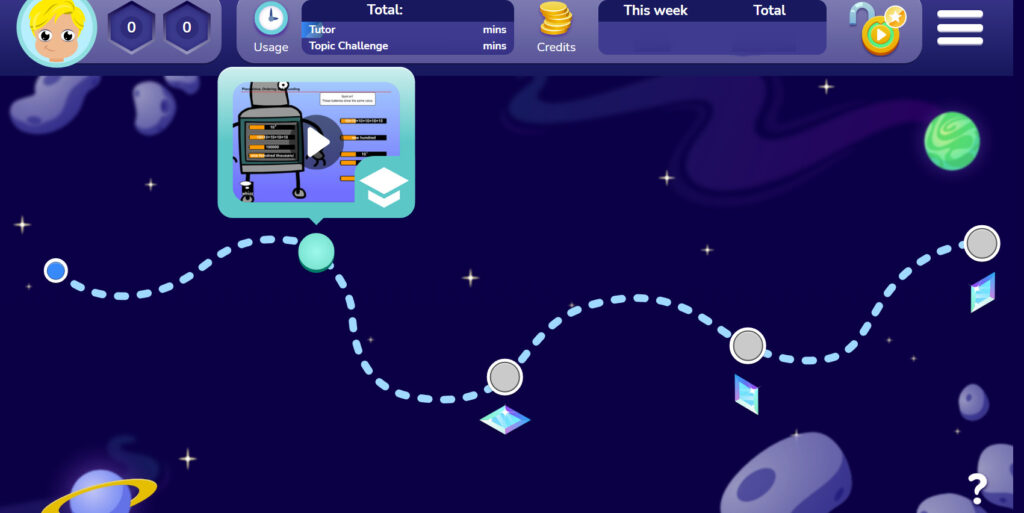
Being developed in the UK, previous editions of the program did have a bit of British content that could be a bit confusing to American students, such as using the pound (£) in some currency-related exercises or making references to UK locations.
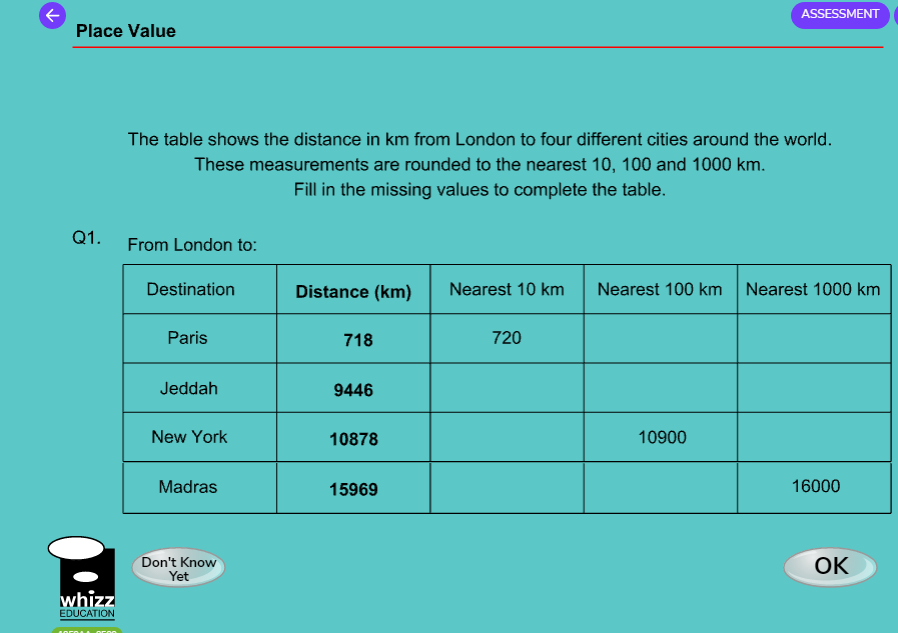
For the most part, when we tested the program we found that, on the whole, it has become adapted to the US, using familiar spelling, currency and more.
That said, from time to time we did see a few questions that might cause some very minor confusion for some students, such as those that used metric measurements or contained some British expressions.
One thing that students and parents should be aware of is that there are loading times between screens, before and after lessons or before and after exercises, which can get a little annoying after a while.
Parent Account
Being a tutoring program aimed at students, the parent’s dashboard is pretty streamlined and focused on helping parents oversee learning.
It has a clean and functional look, using a lot of whitespace, and there aren’t a ton of superfluous options to confuse parents.
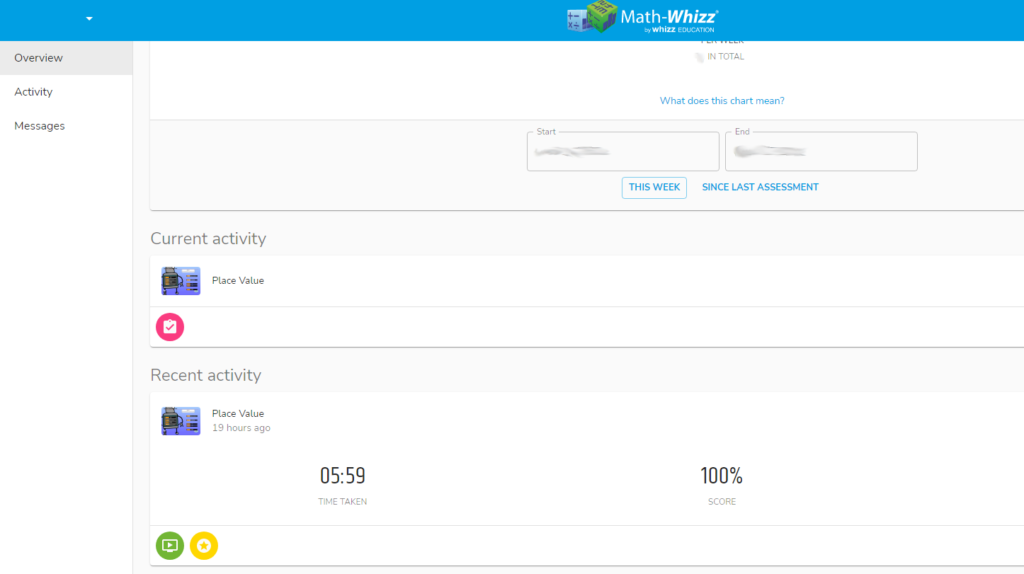
Aside from providing parents the opportunity to manage the student account, the dashboard is mainly centered on monitoring student progress, including their usage of the program, their assessment results, what they’ve been doing recently and how well they are doing in their lessons.
One thing we like is that Math Whizz has included an internal messaging system that lets parents send messages to students, either in general or regarding a specific lesson, which can be helpful in providing encouragement or in reminding students to do their work.

Approach To Teaching Math
Mastery
Math Whizz takes a mastery approach to math instruction.
In the program, topics are worked on one at a time, with students spending time working on their skills across a number of lessons.
They only move on to another topic once they can show proficiency (or mastery) on that skillset in an assessment.
This mastery approach can be very beneficial, letting students spend time diving deeply into a topic and honing their skills one at a time, and it can feel less all over the place compared to a spiral method, which tends to break topics down and teach them a little at a time.
One issue that mastery math programs can have is that students who pick concepts up quickly may feel a bit bogged down by having to study a topic over several lessons.
Math Whizz manages to avoid this issue thanks to its adaptive algorithm, which monitors student responses and ability in real time and which will move forward automatically once students begin to demonstrate proficiency.
That said, students with deeper knowledge gaps may find themselves taking a bit longer with certain concepts with this program, which can slow down or limit the introduction of other topics.
In addition, some students can feel frustrated if they are forced to study one particular concept for long periods of time without moving on.
Online Virtual Tutoring
Math Whizz is a virtual math tutoring program.
This means that rather than being a full math curriculum or supplement, the program assesses specific, grade-related math skills that students should know and, should it find deficits during its assessments, specifically works to hone those skills through direct instruction and targeted exercises.

As a result, students spend less time on concepts they already know and spend more time working on closing specific skill gaps, much like a real tutor.
Math Whizz does this all online, as well.
Students log in and access its materials from any web browser and its digital format allows the program to bring in and use an assortment of digital tools to teach and work on math, such as multimedia tutorials, interactive exercises, adaptive questions, video game drill and more.

It also allows for progress tracking, which lets parents follow up on what their students are learning, how well they are doing and how they are using the program in a fair amount of detail.
All of this serves to create a more dynamic, multisensory and engaging learning environment compared to a standard paper-and-pen workbook.
On the downside, of course, the digital and online nature of Math Whizz means that students will spend more time (an added 45-60 minutes a week) in front of a screen and will need to be left with an internet-enabled device, something that not every parent is comfortable with.
Adaptive Learning
As we’ve mentioned Math Whizz makes rather extensive use of an adaptive algorithm.
Its exercises, assessments and game-based practice can get progressively harder or easier depending on how well a student is doing with them, making learning a bit more personalized and interactive.
It also can provide students with more of a continual and relevant challenge based on their actual skillset, increasing or decreasing the difficulty of learning (or even moving on completely) in relation to their actual responses rather than a set of assumptions, which is where we feel the program most emulates the actions of a tutor.
Self-Study
By and large, Math Whizz is a program that students can use on their own.
Through the use of short, on-screen tutorials, interactive in-lesson exercises and skill-reinforcing games, the program can guide students through both instruction and practice without the need for much in the way of direct parental oversight.
As a result, parents can step back into more of an administration and guidance role, overseeing their student’s schedule and pace of learning, preventing them from getting distracted, keeping tabs on their progress and so on.
All of this not only can promote stronger independent learning skills and ownership of math skill development in students, but it can also be ideal for busier homeschooling families as they won’t have to spend a lot of time teaching or remediating, always a plus for a tutoring program.
How It Works
After subscribing to the program, parents set up individual parent and student accounts, providing students with their own place to work and parents with their own way to keep an eye on things.
After taking the program’s fairly thorough, and lengthy, skills assessment to see where they are skillswise, students are then assigned a “math age,” or proficiency relative to other students their age, across several math topics.
Following this, students are then taken to their main page where they can access their lessons in a given topic (represented on a learning path), do revision video games and earn points or spend time customizing their avatar and its “bedroom” with a variety of virtual items (which they purchase with the aforementioned points).

As the program is based on mastery, students tackle math topics (place value, probability, geometric shapes) one at a time, being provided with a number of focused lessons on each.
The lessons themselves begin with a tutorial.
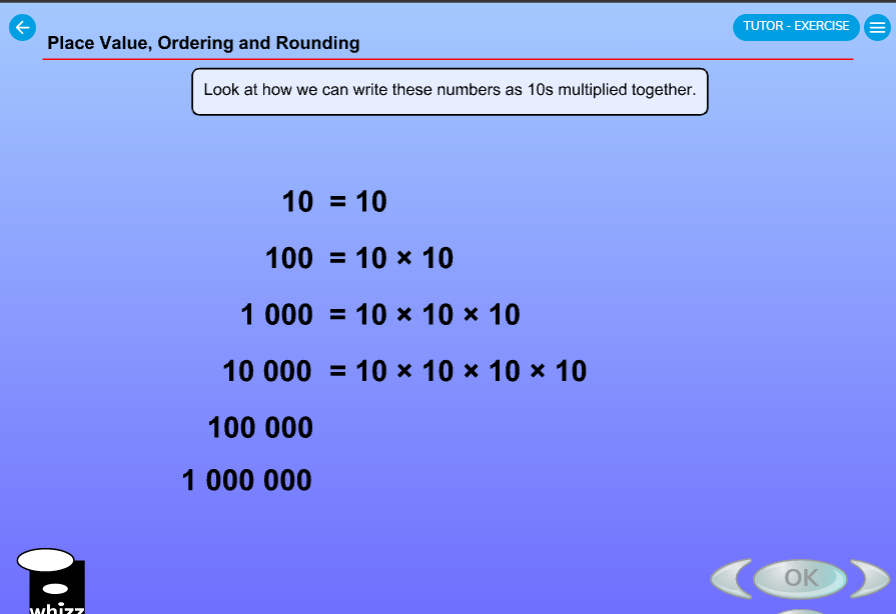
Taking place in a bright cartoon world, information is presented in text form, usually alongside some kind of animation or drawing, which services introduce and demonstrate concepts to students in a more visual way.
Following this, students are given the opportunity to practice what they’ve learned with an interactive, on-screen exercise.
This can involve solving equations by tying in numbers, pulling things around the screen, clicking on buttons, connecting items and more, and these can get more challenging as a student improves their skill. .
These exercises typically start off with a good deal of on-screen help and guidance, which is slowly removed as students progress through the program.
Once these exercises are complete, students do another lesson in the same topic and continue to do so until they are ready (via assessment) to move on to another.
They can also play an assortment of video games, which serve to drill individual skills in a playful, interactive environment, where they can earn points that they can use to unlock new features in the program or when customizing their avatar, a feature that is somewhat similar to other programs such as Smartick, Adventure Academy and some others.
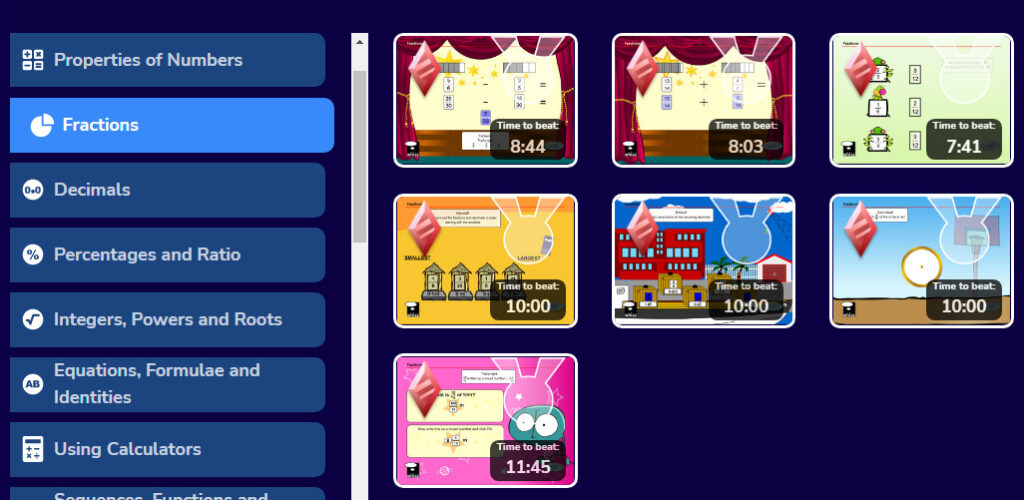
Students also can earn points by completing lessons and doing well in their exercises, earning more depending on how fast or accurately they answer questions, which can be seen as an incentive to develop stronger math fluency.
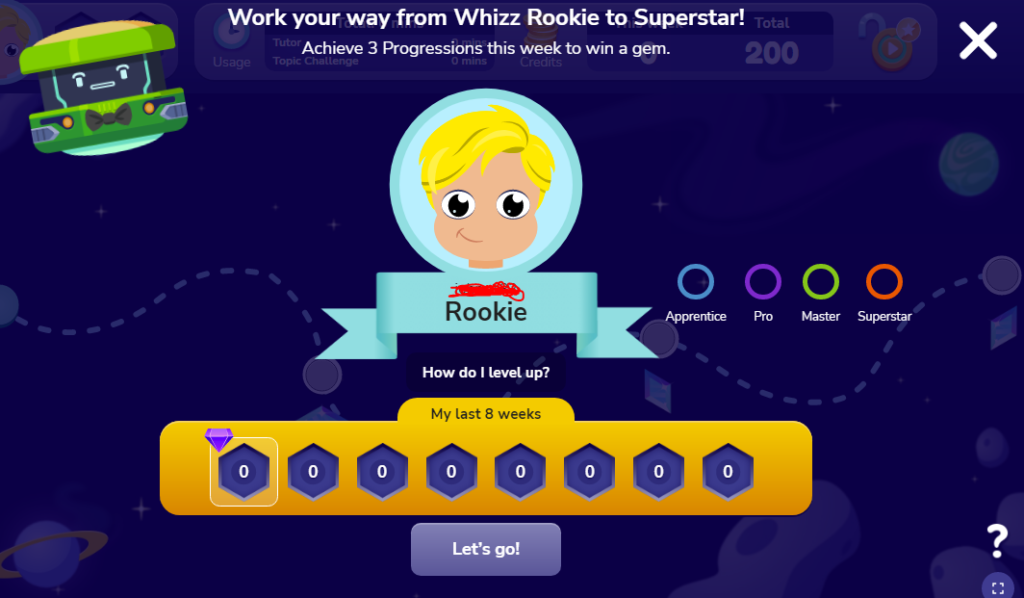
While students are working on their lessons, parents can keep track of their progress via the parent’s dashboard, which offers insights into how much time a student has spent in lessons, what they’ve completed, the skills they’ve worked on and more.
They can also periodically administer assessments, which can measure and record a student’s development in skill and math age.
Our Thoughts
As a virtual math tutoring program, Math Whizz is pretty simple and straightforward to use.
In all, we believe that Math Whizz is pretty well-designed from a tutoring standpoint.
Its focused and individualized approach to teaching math identifies knowledge and skills gaps pretty well and the program keeps its lessons focused on specific skills, using clear, easy to understand audio/visual instructions and demonstrations to convey information.
Much like a real tutor, lessons also involve a lot of student interaction and in-lesson exercises, requiring periodic student input to continue, which keeps students on their toes and prevents them from zoning out.
The program also makes sure that its exercises and practice meets students at their skill level (through the adaptive algorithm), reducing potential frustration in students while keeping lesson practice and instruction just challenging enough to allow skills to really develop and improve.
Additionally, we like the fact that Math Whizz keeps its lessons pretty short.
The program recommends that students spend 20-30 minutes a day twice a week on it, which is quite doable for busy families and not that intimidating a prospect for students, particularly those who already suffer from a fear or dislike of math.
Similarly, the program’s video games and gamified environment, which focus on developing particular skills and keeping students engaged with the program respectively, make the process of learning and reviewing math a lot less stressful and scary than most other math programs.
On the downside, although it does provide very granular data on a student, the program’s placement is quite long and can be challenging for some students to go through.
As a result, some parents may need to keep an eye on their students to make sure they don’t simply click through and receive a lower placement level than they would otherwise.
In a similar vein, students also do need to be prepared for the adaptive component of the games and practice as the increasing difficulty and challenge they will face when they get things right may confuse and frustrate them otherwise.
How Easy Is Math Whizz To Teach With?
Math Whizz is a very easy to use virtual math tutoring program that requires little to no preparation on the part of parents or students to use.
Its lessons are completely guided, carrying students through the instruction, practice and reinforcement of concepts without much risk of them getting lost or the need for any real parental involvement.
At the same time, parents are given enough resources to assess and track student learning, and the clean and functional look of the parent dashboard means everything is very easy to find and access when needed.
The only thing that parents and students need to keep in mind is that the program is not a full curriculum and isn’t really designed to be a primary method of instruction, so students will need to have learned at least the basics of a concept before trying to receive tutoring on it.
Pros And Cons Of Math Whizz
Pros
Approachable, multimedia approach to math instruction/remediation
With its games, visual instruction, gamified learning environment and cartoon graphics, Math Whizz can make working on key math skills a lot less intimidating for students than many other options.
Adaptive technology keeps things challenging
Math Whizz’s adaptive algorithm keeps practice, lessons and assessments an appropriate fit to a student’s abilities, making sure that things remain challenging yet not frustrating.
Provides highly targeted and individual math help
Before a student can start with Math Whizz, they take a comprehensive and adaptive skills assessment that tests them across a wide range of math topics, allowing the program to identify specific knowledge and skills gaps that will then be the main focus of a student’s learning.
Self-study program
Math Whizz is a self-study tutoring program that can carry students through tutorials, exercises and practice without needing a lot of parental involvement or effort.
As a result, it can be a good way of encouraging independent learning and self-improvement while reducing the burden of teaching for busy or uncertain homeschooling parents.
Practice games and gamified learning can help with engagement
Math Whizz offers a wide variety of video games that can help provide students with focused practice across a wide range of math skills in a way that can be a lot more fun than page after page of math drill.
Easy To Use
Math Whizz’s look and feel is pretty intuitive and easy to use, meaning that students are unlikely to get lost while using it and there isn’t a lot in the way of preparation required before using it.
Intuitive and Useful Progress Tracking
The parent’s dashboard in Math Whizz provides parents with an easy way to track how a student is doing in their studies and can yield useful and easy to understand insights into their development down to the level of individual math skills.
Cons
Not the cheapest math program around
While certainly more affordable than live tutoring, at just under $200 per year, Math Whizz isn’t the cheapest digital math tutoring program out there, costing about as much as a complete homeschool math curriculum, and can be a little harder for some families to squeeze into a tight budget.
Placement test is a bit long
Math Whizz’s placement test, while comprehensive and very granular in the data it can yield, can take some time to complete, which can frustrate or tire students.
Who Is Math Whizz Ideal For?
Students who need a little help in K-8 Math
With its personalized and targeted learning plans and adaptive questions, Math Whizz is a high quality virtual tutoring program that can be a good option for students who need some help strengthening their elementary and middle school math skills.
Students who are intimidating by traditional math supplements and programs
Math Whizz’s fun learning environment, simple and understandable tutorials, game-based practice and cartoon graphics can make learning math a lot gentler and more approachable than other math supplements out there, making it a better option for those who have had a hard time with math in the past or are math phobic.
Students who prefer audio and/or visual learning methods
Math Whizz is a very visual and auditory learning program, making use of animations, narration, sound effects and more, to teach and practice math.
It can, therefore, be a good option for students who prefer to learn more audio-visually.
Busy homeschools
A self-study virtual tutoring program, Math Whizz doesn’t require a lot of constant and dedicated parental time and attention, making it a good option for homeschools with packed schedules.
Parents who doubt their own ability to help their student in math
As Math Whizz can assess, identify and work to ameliorate specific skill gaps in math with minimal parental input, it can be a good option to help students whose parents feel as if their own math skills are a little too rusty.
Students who hate traditional drill and practice
Although it does encourage students to practice specific skills through drill-like exercises, Math Whizz does use games and rewards to help make them a bit more enjoyable compared to traditional workbook-based drills.
Who Is it Not Ideal For?
Those looking for a full K-8 math curriculum
Although it does a good job at explaining concepts and providing practice, Math Whizz is intended to address and remediate specific skill and knowledge gaps rather than to be used as a primary teaching curriculum.
Those looking to minimize or reduce screen time
An web-based program with no real paper-based materials involved in its exercises, Math Whizz can increase the amount of time students spend online and in front of a screen, which can be an issue for some parents.
Price
Note: prices correct as of writing, all prices in USD.
⭐ Free 7 day trial available, requires credit card.
Math Whizz can be purchased as a monthly or yearly subscription, costing either $24.99 per month or $199.99 per year per student for unlimited access.
As always parents should check for the latest prices, as well as for any discounts that might be offered.
Is It Worth It?
Although it’s not necessarily the cheapest math program around, we do feel that Math Whizz can provide a lot of value to homeschooling families.
With its adaptive placement and analysis, Math Whizz can identify specific skill and knowledge gaps in students and provide focused math instruction and practice to help students improve in the areas they need the most help in.
It does so using clear and easy to understand standards aligned tutorials and exercises, which are animated using a fairly modern style and use fun, gamified features to maximize student attention, engagement and interest.
Finally, it provides parents with sophisticated progress tracking tools that can be used to not only keep things on track but to derive potentially valueable and important insights into a student’s math development.
Bottom Line
With its colorful and fun graphics, gamified learning environment, intelligent adaptive algorithm and clear and understandable tutorials, Math Whizz can be a highly effective, approachable and efficient way of identifying and remediating skill gaps in K-8 math.
It can ultimately help students become more confident math learners and make math a less stressful subject for all involved.

About the Author
David Belenky is a freelance writer, former science and math tutor and a tech enthusiast. When he’s not writing about educational tech, he likes to chill out with his family and dog at home.
